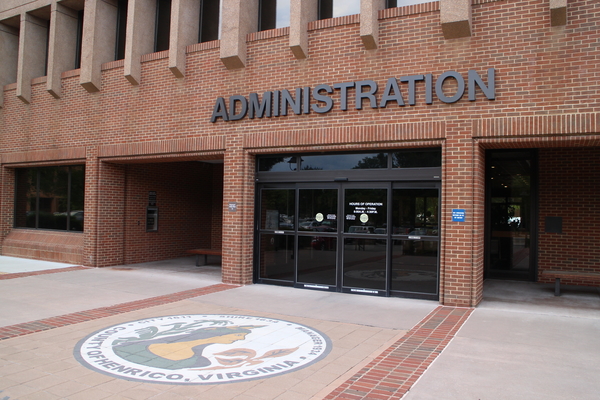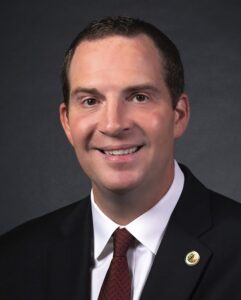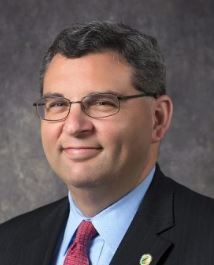Looking to fill vacancies that amount to one-tenth of existing office space in the county, administrators in Henrico are planning to resume their recent practice of promoting economic investment by exempting more businesses from paying business license taxes.
And where it has previously increased its threshold for exemption in $100,000 increments over several years, the county this year is looking to double its exemption threshold for the so-called BPOL (Business, Professional, Occupational License) tax – from its current $500,000 level to $1 million.
The move would make businesses’ first $1 million in gross receipts exempt from the county’s BPOL tax rate of 20 cents per $100 and is included in the proposed fiscal year 2025 budget that was presented to county supervisors Tuesday evening.
The increase would exempt an additional 1,300 businesses in the county, bringing the total number of businesses that would pay no BPOL tax to 15,800, according to the county. That’s about 83 percent of the 19,000 businesses that are or would be subject to the county’s BPOL tax.
Of the remaining businesses that would continue to pay BPOL, 3,000 would see a reduction in their BPOL tax bills as a result of the increase, said Brandon Hinton, Henrico’s deputy county manager for administration.
Hinton said the increase would benefit more small- to medium-size businesses in the county, describing the bulk of its BPOL taxes as coming from larger businesses such as big-box retailers and grocery stores.
“This really helps your smaller to mid-size businesses thrive,” he said. “They can not worry about having to pay as much BPOL tax and focus on other areas.”
Anthony Romanello, Henrico’s economic development director, described the larger tax exemption as another tool in his department’s toolkit for attracting business to the county, adding to reductions in recent years to the county’s machinery, data center and biotech tax rates.
“It’s going to help hundreds of businesses in the county and, we think, will be a really good differentiator for us as we continue on this path of working with our business community,” Romanello said.
“We’ve got good data that shows how lowering the tax burden on the business community raises investment, raises county revenue, and we have every reason to believe this increase in the BPOL threshold will do just the same,” he said.
Since Henrico’s last exemption increase in 2021, when the threshold rose from $400,000 to $500,000, Hinton said BPOL tax receipts have grown by $12.5 million, or nearly 33 percent, over those two fiscal years.
Reaching $500,000 was a goal that Hinton said the county had set internally years earlier. The county started the increases in 2017, when the threshold went up from $100,000 to $200,000.
Neighboring localities followed suit with their own BPOL increases, with Chesterfield County catching up to Henrico last year with its own $500,000 exemption amount. The City of Richmond has also increased its BPOL exemption, which stands at $250,000 and allows eligible new businesses to instead pay a $30 annual fee for up to two years.
Henrico’s BPOL tax rate for most businesses stands at 20 cents per $100. Chesterfield’s is similar, while the city’s rate varies from around 20 cents for retailers, wholesalers and contractors, to 58 cents for business, professional and financial services.
While the jump to a $1 million threshold would keep Henrico competitive with its neighbors, Romanello said it was driven in part by the ongoing challenges facing office space following the remote-work trends that came with the pandemic. He said the county’s office vacancy rate is currently 11.3 percent, according to CoStar data.
“Every company in the world for the last couple of years has been evaluating office space. As our companies, commercial property owners and office building owners are evaluating space, we want to make sure that we’re providing them with maximum flexibility as they continue to make space decisions, as they continue to make investment decisions,” Romanello said.
“By moving the threshold from $500,000 to $1 million, we’re picking up another 1,300 businesses, 3,000 businesses will see their BPOL taxes go down, and we think that’s going to be just one more Henrico differentiator,” he said.
The $1.4 billion FY25 budget plan presented Tuesday maintains the current real estate tax rate of 85 cents per $100 of assessed value and includes a $1.25 billion general fund – up $97.6 million, or 8.4 percent, from the current budget.
The proposal recommends a 4.8 percent salary increase for all eligible county employees, and it includes a capital budget totaling $327 million, with about $111 million allocated for projects approved in the 2022 bond referendum, $120 million in water and sewer infrastructure improvements, and $30 million for road and pedestrian projects.
Supervisors will review the budget plan in detail during work sessions scheduled next week. Public hearings on the budget, which the county must adopt before the fiscal year starts on July 1, are scheduled March 26 at 5 p.m. and April 9 at 6 p.m. The proposed budget can be viewed in full on the county’s website.
Looking to fill vacancies that amount to one-tenth of existing office space in the county, administrators in Henrico are planning to resume their recent practice of promoting economic investment by exempting more businesses from paying business license taxes.
And where it has previously increased its threshold for exemption in $100,000 increments over several years, the county this year is looking to double its exemption threshold for the so-called BPOL (Business, Professional, Occupational License) tax – from its current $500,000 level to $1 million.
The move would make businesses’ first $1 million in gross receipts exempt from the county’s BPOL tax rate of 20 cents per $100 and is included in the proposed fiscal year 2025 budget that was presented to county supervisors Tuesday evening.
The increase would exempt an additional 1,300 businesses in the county, bringing the total number of businesses that would pay no BPOL tax to 15,800, according to the county. That’s about 83 percent of the 19,000 businesses that are or would be subject to the county’s BPOL tax.
Of the remaining businesses that would continue to pay BPOL, 3,000 would see a reduction in their BPOL tax bills as a result of the increase, said Brandon Hinton, Henrico’s deputy county manager for administration.
Hinton said the increase would benefit more small- to medium-size businesses in the county, describing the bulk of its BPOL taxes as coming from larger businesses such as big-box retailers and grocery stores.
“This really helps your smaller to mid-size businesses thrive,” he said. “They can not worry about having to pay as much BPOL tax and focus on other areas.”
Anthony Romanello, Henrico’s economic development director, described the larger tax exemption as another tool in his department’s toolkit for attracting business to the county, adding to reductions in recent years to the county’s machinery, data center and biotech tax rates.
“It’s going to help hundreds of businesses in the county and, we think, will be a really good differentiator for us as we continue on this path of working with our business community,” Romanello said.
“We’ve got good data that shows how lowering the tax burden on the business community raises investment, raises county revenue, and we have every reason to believe this increase in the BPOL threshold will do just the same,” he said.
Since Henrico’s last exemption increase in 2021, when the threshold rose from $400,000 to $500,000, Hinton said BPOL tax receipts have grown by $12.5 million, or nearly 33 percent, over those two fiscal years.
Reaching $500,000 was a goal that Hinton said the county had set internally years earlier. The county started the increases in 2017, when the threshold went up from $100,000 to $200,000.
Neighboring localities followed suit with their own BPOL increases, with Chesterfield County catching up to Henrico last year with its own $500,000 exemption amount. The City of Richmond has also increased its BPOL exemption, which stands at $250,000 and allows eligible new businesses to instead pay a $30 annual fee for up to two years.
Henrico’s BPOL tax rate for most businesses stands at 20 cents per $100. Chesterfield’s is similar, while the city’s rate varies from around 20 cents for retailers, wholesalers and contractors, to 58 cents for business, professional and financial services.
While the jump to a $1 million threshold would keep Henrico competitive with its neighbors, Romanello said it was driven in part by the ongoing challenges facing office space following the remote-work trends that came with the pandemic. He said the county’s office vacancy rate is currently 11.3 percent, according to CoStar data.
“Every company in the world for the last couple of years has been evaluating office space. As our companies, commercial property owners and office building owners are evaluating space, we want to make sure that we’re providing them with maximum flexibility as they continue to make space decisions, as they continue to make investment decisions,” Romanello said.
“By moving the threshold from $500,000 to $1 million, we’re picking up another 1,300 businesses, 3,000 businesses will see their BPOL taxes go down, and we think that’s going to be just one more Henrico differentiator,” he said.
The $1.4 billion FY25 budget plan presented Tuesday maintains the current real estate tax rate of 85 cents per $100 of assessed value and includes a $1.25 billion general fund – up $97.6 million, or 8.4 percent, from the current budget.
The proposal recommends a 4.8 percent salary increase for all eligible county employees, and it includes a capital budget totaling $327 million, with about $111 million allocated for projects approved in the 2022 bond referendum, $120 million in water and sewer infrastructure improvements, and $30 million for road and pedestrian projects.
Supervisors will review the budget plan in detail during work sessions scheduled next week. Public hearings on the budget, which the county must adopt before the fiscal year starts on July 1, are scheduled March 26 at 5 p.m. and April 9 at 6 p.m. The proposed budget can be viewed in full on the county’s website.






It is nice that the county is having less companies pay the War of 1812 tax. But I question why the tax exists at all. That war is long over, I hope. But taxes never die. Any tax on revenues without regard to profit is an issue for me.
Stoney, city council…. are you watching?
Yeah funny article failed to mention the rates in RVA that do start at $.19 per hundred but only for contractors. Restaurants and repair services are $.36 per hundred and professional service business pay $.58 per hundred. And that flat fee is ONLY for new business in the first two years of operation so that they can GET you on the books for that increase in year 3 if you make it!
What is strange about Richmond is they had a case were last year the tax revenue went up $300 million over last year but the money going into street paving got reduced and sidewalk repairs didn’t go up.
As usual Henrico County is extending its competitive position with the surrounding jurisdictions. It further incentivizes businesses to locate or re-locate to the County.
I’m glad they posted the data showing the new tax revenue the tax cuts brought in in that it’s rare you see the facts that support the tax cuts.
The good news is it’s 12 million more sidewalks.